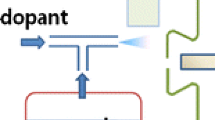Abstract
A pilot study was performed to evaluate a new concept for a radiation biodosimetry method. Proton transfer reaction-mass spectrometry (PTR-MS) was used to find out whether radiation induces changes in the composition of volatile organic compounds (VOCs) in the headspace of in vitro cultured cells. Two different cell lines, retinal pigment epithelium cells hTERT-RPE1 and lung epithelium cells A-549, were irradiated with gamma radiation at doses of 4 Gy and 8 Gy. For measuring the cell-specific effects, the VOC concentrations in the headspace of flasks containing cells plus medium, as well as of flasks containing pure medium were analyzed for changes before and after irradiation. No significant radiation-induced alterations in VOC concentrations in the headspace could be observed after irradiation.







Similar content being viewed by others
References
Allardyce RA, Hill AL, Murdoch DR (2006) The rapid evaluation of bacterial growth and antibiotic susceptibility in blood cultures by selected ion flow tube mass spectrometry. Diagn Microbiol Infect Dis 55:255–261
Amann A, Poupart G, Telser S, Ledochowski M, Schmid A, Mechtcheriakov S (2004) Applications of breath gas analysis in medicine. Int J Mass Spectrom 239:227–233
Brunner C, Szymczak W, Höllriegl V, Mörtl S, Oelmez H, Bergner A, Huber RM, Hoeschen C, Oeh U (2010) Discrimination of cancerous and non-cancerous cell lines by headspace-analysis with PTR-MS. Anal Bioanal Chem 397:2315–2324
Bunge M, Araghipour N, Mikoviny T, Dunkl J, Schnitzhofer R, Hansel A, Schinner F, Wisthaler A, Margesin R, Mark TD (2008) On-line monitoring of microbial volatile metabolites by Proton Transfer Reaction-Mass Spectrometry. Appl Environ Microbiol 74:2179–2186
Carroll W, Lenney W, Wang TS, Spanel P, Alcock A, Smith D (2005) Detection of volatile compounds emitted by Pseudomonas aeruginosa using selected ion flow tube mass spectrometry. Pediatr Pulmonol 39:452–456
Giard DJ, Aaronson SA, Todaro GJ, Arnstein P, Kersey JH, Dosik H, Parks WP (1973) In vitro cultivation of human tumors: establishment of cell lines derives from a series of solid tumors. J Natl Cancer Inst 51:1417–1423
Greiter M (2003) Breath gas analysis with Proton-Transfer-Reaction-Mass-Spectrometry (PTR-MS). Diploma thesis, Technical University of Munich, Munich
Hansel A, Jordan A, Holzinger R, Prazeller P, Vogel W, Lindinger W (1995) Proton transfer reaction mass spectrometry: online trace gas analysis at the ppb level. Int J Mass Spectrom Ion Process 149–150:609–619
Kato S, Burke PJ, Koch TH, Bierbaum VM (2001) Formaldehyde in human cancer cells: Detection by preconcentration-chemical ionization mass spectrometry. Anal Chem 73:2992–2997
Lieber M, Smith B, Szakal A, Nelson-Rees W, Todaro G (1976) A continuous tumor-cell line from a human lung carcinoma with properties of type II alveolar epithelial cells. Int J Cancer 17:62–70
Lindinger W, Hansel A, Jordan A (1998) On-line monitoring of volatile organic compounds at pptv levels by means of Proton-Transfer-Reaction Mass Spectrometry (PTR-MS) Medical applications, food control and environmental research. Int J Mass Spectrom Ion Process 173:191–241
Miekisch W, Schubert JK, Noeldge-Schomburg GFE (2004) Diagnostic potential of breath gas analysis - focus on volatile organic compounds. Clin Chim Acta 347:25–39
Mikoviny T, Bunge M, Araghipour N, Margesin R, Schinner F, Wisthaler A, Märk T (2007) Emission of volatile compounds from bacterial cultures. 3rd International Conference on PTR-MS and its Applications. Obergurgl
Moeskops B, Steeghs M, Kv Swam, Cristescu S, Scheepers P, Harren F (2006) Real-time trace gas sensing of ethylene, propanal and acetaldehyde from human skin in vivo. Physiol Meas 27:1187–1196
Phillips M, Cataneo RN, Ditkoff B, Fisher P, Greenberg J, Gunawardena R, Kwon S, Rahbari-Oskoui F, Wong C (2003) Volatile markers of breast cancer in the breath. Breast J 9:184–191
Phillips M, Cataneo RN, Cheema T, Greenberg J (2004) Increased breath biomarkers of oxidative stress in diabetes mellitus. Clin Chim Acta 344:189–194
Phillips M, Altorki N, Austin J, Cameron R, Cataneo R, Greenberg J, Kloss R, Maxfield R, Munawar M, Pass H, Rashid A, Rom W, Schmitt P (2007a) Prediction of lung cancer using volatile biomarkers in breath. Cancer Biomark 3:95–109
Phillips M, Cataneoa RN, Condos R, Ring Ericksond GA, Greenberg J, Vincent La Bombardie, Munawara MI, Tietjef O (2007b) Volatile biomarkers of pulmonary tuberculosis in the breath. Tuberculosis 87:44–52
Smith D, Wang T, Spanel P (2002) Kinetics and isotope patterns of ethanol and acetaldehyde emissions from yeast fermentations of glucose and glucose-6, 6–d2 using selected ion flow tube mass spectrometry: a case study. Rapid Commun Mass Spectrom 16:69–76
Smith D, Wang TS, Sule-Suso J, Spanel P, El Haj A (2003) Quantification of acetaldehyde released by lung cancer cells in vitro using selected ion flow tube mass spectrometry. Rapid Commun Mass Spectrom 17:845–850
Steeghs MML, Moeskops B, van Swam K, Cristescu SM, Scheepers PTJ, Harren FJM (2006) On-line monitoring of UV-induced lipid peroxidation products from human skin in vivo using proton-transfer reaction mass spectrometry. Int J Mass Spectrom 253:58–64
Steinbacher A, Dommen J, Ammann C, Spirig C, Neftel A, Prevot ASH (2004) Performance characteristics of a proton-transfer-reaction mass spectrometer (PTR-MS) derived from laboratory and field measurements. Int J Mass Spectrom 239:117–128
Vaziri H, Benchimo S (1998) Reconstitution of telomerase activity in normal human cells leads to elongation of telomeres and extended replicative life span. Curr Biol 8:279–282
Acknowledgments
We would like to thank Klaudia Winkler and Romy Müller from the Institute of Radiation Biology of the Helmholtz Zentrum München, for providing the cells, the laboratory and the know-how for handling of in vitro cultured cells. We would also like to thank Lothar Keck, Bhushan Thekedar and Florian Wagner from the Institute of Radiation Protection for plenty of assistance with the development of the experimental setup and the data analysis.
Author information
Authors and Affiliations
Corresponding author
Rights and permissions
About this article
Cite this article
Brunner, C., Szymczak, W., Li, W. et al. Headspace measurements of irradiated in vitro cultured cells using PTR-MS. Radiat Environ Biophys 50, 209–217 (2011). https://doi.org/10.1007/s00411-010-0327-8
Received:
Accepted:
Published:
Issue Date:
DOI: https://doi.org/10.1007/s00411-010-0327-8




